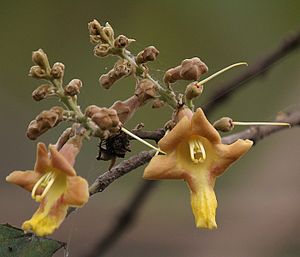Gmelina arborea
| Gmelina arborea | ||||||||||||
|---|---|---|---|---|---|---|---|---|---|---|---|---|

Flowers of Gmelina arborea |
||||||||||||
| Systematics | ||||||||||||
|
||||||||||||
| Scientific name | ||||||||||||
| Gmelina arborea | ||||||||||||
| Roxb. ex Sm. |
Gmelina arborea is a plant from the family of the mint (Lamiaceae). It is native to Southeast Asia and India , but is widely grown in the tropics.
description
Gmelina arborea is a fast-growing, deciduous tree that reaches heights of 12 to 30, rarely even 40 meters. The trunk is often knot-free in the lower 6 to 9 meters, sometimes crooked and the tree crown is broadly spreading. The trunk diameter reaches up to 80-140 centimeters. The bark is gray-brown and relatively smooth to somewhat rough and slightly cracked. The wood is pale yellow in color and is soft to moderately hard. The young twigs are slightly square in cross-section, they are densely hairy brown. Older branches have smooth gray-brown bark.
The stalked, opposite and entire leaves are simple, 10 to 25 inches long and 7 to 20 inches wide. The petiole is 5–15 centimeters long and slightly hairy to bald. A few glands are located at the transition from the leaf stalk to the leaf blade. The leaf blade is broadly ovate to slightly heart-shaped, at the base of the petiole pointed to blunt and the tip is pointed to acuminate. On young plants, the leaves are sometimes roughly toothed to lobed away. The leaves are, underneath more, light, more or less velvety hairy to bald, they are partly lepidotes, scaly. The nerve is usually threefold to palmate. The stipules are usually missing.
The 15 to 30 centimeters long, stalked inflorescences are thyrsenic , they are terminally on the branches, the inflorescence axis is hairy. The single, short-stalked, hermaphrodite and five-fold bloom with a double bloom is about 4 centimeters long, bell-shaped, orange, yellow and brownish in color. The pedicels have sloping bracts . The green, cup-shaped and hairy calyx is small with small tips. The crown, fine-haired on the outside and on the corolla lobes, is two-lipped and in the corolla tube and on the lower, middle and longer lobes, almost bald and yellow. The four, slightly protruding stamens are didynamic, with slightly hairy stamens. The four-chamber ovary is on top, the style is long, with a two-lobed stigma .
The flowering period takes place in February to April, the fruit formation from May to June. The monotonous to rounded, leathery and smooth, shiny stone fruits , with a permanent calyx, are yellow when ripe and are about 2.5–4 centimeters tall. The green-yellowish flesh is juicy and bitter-sweet. The relatively smooth, mostly 1–2 bony stone cores are light brown and egg-shaped.
The number of chromosomes is 2n = 40.
Distribution and habitat
Gmelina arborea is native to India, Southeast Asia ( Myanmar , Thailand , Laos , Cambodia , Vietnam , Philippines ) and the southern provinces of China . The tree rises to altitudes of 1500 meters. As a plantation tree, it can be found in the entire tropical region.
Gmelina arborea prefers fresh soils with 750 to 4500 mm annual precipitation. But it can also grow in drier regions with dry periods of six to seven months.
use
The juicy fruits are edible and bitter-sweet. The flowers are also eaten.
The wood is used for garden furniture, construction timber , carriages, sports, musical instruments and artificial limbs. The versatile wood has the trade names Gmelina, Yemane, Gumhar, Malay beechwood, Mai Saw, So, So-Maeo.
The root and bark are pharmacologically u. a. used in the manufacture of laxatives and means to improve appetite. Different parts of the tree are used in folk medicine: The brew of the leaves, roots or bark as well as the fruits.
Systematics
Synonyms for Gmelina arborea Roxb. ex Sm. are Gmelina rheedei Hook. , Gmelina sinuata Link , Gmelina oblongifolia Roxb. and Premna arborea Roth .
literature
- James A. Duke: Handbook of Energy Crops. 1983, unpublished. online at Purdue.
- Shou-liang Chen, Michael G. Gilbert: Verbenaceae . In: Wu Zhengyi, Peter H. Raven, Hong Deyuan (eds.): Flora of China . Vol. 17, p. 33 ( efloras.org ).
- HG Richter & MJ Dallwitz: Gmelina arborea. In: Commercial Timbers. June 25, 2009. Retrieved December 26, 2014 .
- Michel Arbonnier: Trees, Shrubs and Lianas of West African Dry Zones. CIRAD, 2004, ISBN 978-2-7592-0674-2 , p. 506.
Web links
- Gmelina arborea . In: U. Brunken, M. Schmidt, S. Dressler, T. Janssen, A. Thiombiano, G. Zizka: West African plants - A Photo Guide. Senckenberg Research Institute, Frankfurt am Main 2008.
- Gmelina arborea at Useful Tropical Plants.
- Róger Moya, Mario Tomazello Fo: Variation in the wood anatomical structure of Gmelina arborea (Verbenaceae) trees at different ecological conditions in Costa Rica. In: Rev. Biol. Trop. (Int. J. Trop. Biol.), Vol. 56, No. 2, 2008, pp. 689-704, online (PDF; 1.1 MB).
- Mohammed Kamal Hossain: Fact Sheet Gmelina arborea. FACT 99-05, Forest Farm and Community Network, 1999, online (PDF).
- Somyos Kijkar: Gmelina arborea. In: JA Vozzo: Tropical Tree Seed Manual. USDA Forest Service, 2002, p. 476 ff, online (PDF).
Individual evidence
- ↑ PF Stevens (2001+): Angiosperm Phylogeny website [1]
- ^ Gmelina arborea at Tropicos.org. In: IPCN Chromosome Reports . Missouri Botanical Garden, St. Louis
- ↑ Rafaël Govaerts (ed.): Gmelina arborea. In: World Checklist of Selected Plant Families (WCSP) - The Board of Trustees of the Royal Botanic Gardens, Kew . Retrieved September 7, 2019.
